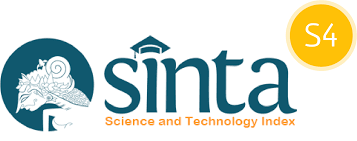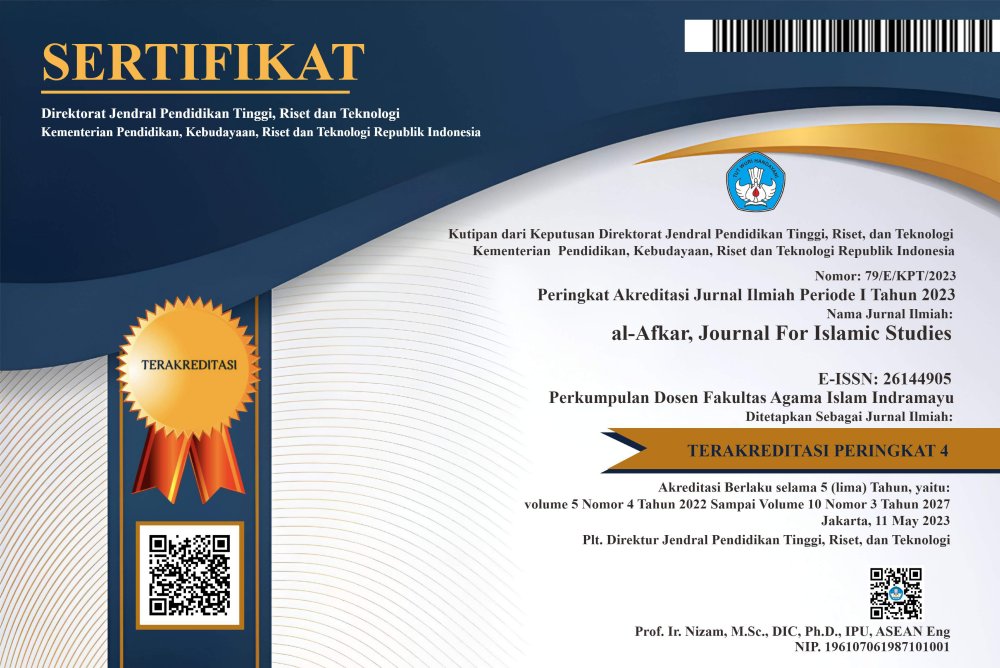The Meaning of the Word Al Mishbah in the Qur’an with Toshihiko Izutsu Semantic Analysis
DOI:
https://doi.org/10.31943/afkarjournal.v7i4.1688Keywords:
Al-Mishbah, Alquran, SemanticAbstract
This study examines the meaning of the term "Al-Mishbah" in the Qur'an through a semantic analysis conducted by Toshihiko Izutsu. The term "Al-Mishbah," which literally means "lamp" or "light," has profound implications in both spiritual and moral contexts. In this research, the author explores how "Al-Mishbah" functions as a symbol of divine illumination that provides guidance to humanity. Using Izutsu's semantic approach, this article identifies the connections between "Al-Mishbah" and other concepts in Islamic thought, such as "nur" (light) and "iman" (faith), while highlighting the importance of the pursuit of truth and moral integrity in daily life. The purpose of this research is to explore the various dimensions of the meaning of "Al-Mishbah" within the context of the Islamic worldview and how this term serves as a symbol of divine guidance for humanity. The research method employed in this study is qualitative analysis with a semantic approach, encompassing the study of Qur'anic texts, interpretations of Hadith, and literature related to Toshihiko Izutsu's thought. The author also examines the relationship of "Al-Mishbah" with other concepts in Islamic thought, such as "nur" (light) and "iman." Through this analysis, the article demonstrates that understanding "Al-Mishbah" not only enriches the interpretation of the Arabic language but also deepens the insight into how divine light can guide individuals in their spiritual journeys, as well as foster collective awareness within the community.
Downloads
References
Ahmad Sahidah, P. . (2018). God, Man, and Nature.
Ahmad Zainal Abidin, T. A. &. (2017). Tafsir Moderat Konsep Jihad Dalam Perspektif M. Quraish Shihab. Kontemplasi: Jurnal Ilmu-Ilmu Ushuluddin, 5(2).
Amatullah, R. S., Wahyudi, W., Fm, D. Z. A., Nurrohmah, M., & Sumarni, E. (2024). Makna Qoryah dalam Al-Quran dan Kaitannya dengan Lingkungan Pendidikan Islam (Analisis Semantik Karya Toshihiku Izutsu). Al-Muhith: Jurnal Ilmu Qur’an Dan Hadits, 2(1), 30.
AN, A. N. (2013). Konsep Islamic State Amien Rais dan Nurcholish Madjid. Jurnal Substantia, 15(1), 41–52.
An, A. N., Alfian, M. Y., Saifudin, & Akhyar, S. (2021). Implementasi Metode Tafsir Tahlili Terhadap Qs Ar-Rum Ayat 30 Tentang Fitrah Manusia dalam Tafsir Azhar untuk Membendung Embrio Paham Atheis. Al-Tadabbur: Jurnal Ilmu Al Quran Dan Tafsir, 6(2). https://doi.org/10.30868/at.v6i02.2082
AN, A. N., & Cahyo, E. D. (2023). Ushul Tafsir and Qawaid Tafsir Nusantara: A Review Of Nawawi Al Bantani’s Book Of Tafsir Marah Labid. Syariati: Jurnal Studi Al-Qur’an Dan Hukum, 8(2), 153–162. https://doi.org/10.32699/syariati.v8i2.4249
AN, A. N., & Zaglul Fitrian. (2020). PENALARAN ISTISLAHI TERHADAP TINDAKAN EUTHANASIA BERBASIS AYAT-AYAT AHKAM. Al-Munir: Jurnal Studi Ilmu Al-Qur’an Dan Tafsir, 2(01), 107–146. https://doi.org/10.24239/al-munir.v2i01.49
Aozora Tawazun, J., Fathiyyah, K., & Anam, K. (2023). Understanding the Meaning of Liberalism from the Maudhu’i Interpretation Perspective in the Qur’an. Bulletin of Islamic Research, 1(4), 161–174. https://doi.org/10.69526/bir.v1i4.48
Ardiansyah, R. (2018). Konsep Akal Dalam Tafsir Al-Misbah.
Astuti, A. A., Aryani, S. A., Hidayat, S., . W., N, Andri Nirwana, A., & . M. (2024). Parent Practices of SMPIT Insan Mulia Surakarta in Implementing Sexual Education from An Islamic Perspective to Children in The Digital Era. International Journal of Religion, 5(10), 2092–2109. https://doi.org/10.61707/6msvvh24
Azizah, A., Firmansyah, Dahliana, Y., & Iqbal, M. (2024). INTERNALISASI PEMAHAMAN AL-QUR`AN DALAM BENTUK MACAPAT SEKAR SARI KIDUNG RAHAYU. Al-Bayan: Jurnal Studi Ilmu Al-Qur’an Dan TafsirStudi Ilmu Al-Qur’an Dan Tafsir, 9(1), 129–141. https://doi.org/10.15575/al-bayan..v9i1.38047
Basir, A., Suri, S., Nirwana AN, A., Sholihin, R., & Hayati, H. (2022). relevance of national education goals to the guidance of the Al-Quran and Al-Hadith. Linguistics and Culture Review, 6, 122–137. https://doi.org/10.21744/lingcure.v6nS5.2088
Beni, A. N. (2024). Qur’an and Climate Change. QiST: Journal of Quran and Tafseer Studies, 3(3), 339–360. https://doi.org/10.23917/qist.v3i3.5276
Budi Raharjo, Y. D. (2015). KRITIK TERHADAP DESAKRALISASI KALIMAT TAYYIBAH (Analisis Surat At-Taubah Ayat 65-66 Perspektif Tafsir Al-Misbah). 6.
Choirunnisa, A., Ushuluddin, F., Negeri, U. I., & Hidayatullah, S. (2024). PEMAKNAAN TERM WAZIR DALAM AL- QUR ’ AN ( Studi Pendekatan Semantik Toshihiko Izutsu ) PEMAKNAAN TERM WAZIR DALAM AL- QUR ’ AN ( STUDI PENDEKATAN SEMANTIK TOSHIHIKO IZUTSU ). Skripsi Universitas Islam Negeri Syarif Hidayatullah Jakarta.
Dahliana, Y., & Wahab, A. I. P. (2023). Makna Mitsaqan Ghalizhan Perspektif Tafsir Al-Munir: Kajian atas Surah An-Nisa: 21. AN NUR: Jurnal Studi Islam , 15(2 SE-Articles), 257–270. https://doi.org/10.37252/annur.v15i2.646
Dhea Salsabila, A. S., Tsabithania Arifiy, A., & Nursyifa Fitri, C. (2023). Study of Maudhu’i’s Interpretation of Secularism Verses. Bulletin of Islamic Research, 1(4), 143–160. https://doi.org/10.69526/bir.v1i4.43
Elbashir, A. M., Alkhair, S., & Al-Thani, N. J. (2024). Fostering STEM Learning: Exploring the Integration of Design Thinking in Islamic STEM Education. QiST: Journal of Quran and Tafseer Studies, 3(3), 411–432. https://doi.org/10.23917/qist.v3i3.6138
Eva Eri Dia, & Silmy Rosydah. (2021). Kajian Semantik : Makna Konotasi Pada Rubrik Opini “Jati Diri” Harian Jawa Pos. Jurnal Pendidikan Tambusai, 5(2), 3508–3525.
Fadhilah, U., & Nugroho, K. (2022). Semantik Analysis of Toshihiko Izutsu in the Phrase Al- Urwatul Wutsqo. Iseth 2023, 1510–1516.
Fahimah, S. (2020). Al-Quran dan Semantik Toshihiko Izutsu. Jurnal Al-Fanar, 3(2). https://doi.org/10.33511/alfanar.v3n2.113-132
Ginting, H., & Ginting, A. (2019). Beberapa Teori Dan Pendekatan Semantik. Pendidikan Bahasa Indonesia Dan Sastra (Pendistra), 71–78.
Habib. (2014). Semantik Kata Nisa Dalam Al-Qur’an; Analisis Semantik. Hermeneutika, viii(1).
Haikal Azumardi Azra, A., Cahya Ratri, B., & Azam Firdaus, C. (2023). Islam and Religious Pluralism in the Perspective of the Al-Qur’an and Tafsir Scholars. Bulletin of Islamic Research, 1(4), 115–126. https://doi.org/10.69526/bir.v1i4.36
Hamimi, A. I., Nurcholisho, L. R., Fatkhurrohman, F., Ngazizah, N., & Sunarko, A. (2022). Kata Fasad dalam Al Quran (Analisis Semantik Al Quran). Lisanan Arabiya: Jurnal Pendidikan Bahasa Arab, 6(2), 181–198.
Hanafi, W. (2017). Linguistik Al-Qur’an (Reinterpretasi Makna Manusia di Balik Surat al-Fâtihah Dalam Wacana Semantik). Studia Quranika, 2(1), 1–22.
Hidayah, N., Rasyid, A. R. Al, & Windarto, C. (2024). Meaning of The Word Ta’lamun in The Qur’an. QiST: Journal of Quran and Tafseer Studies, 3(3), 433–450. https://doi.org/10.23917/qist.v3i3.5166
Hidayat, S., & Khaq, I. (2024). Living Quran Surat Al-’Asr To Instill Moral Values and Develop A Progressive Muhammadiyah. Revista de Gestão Social e Ambiental, 18(6), e05715. https://doi.org/10.24857/rgsa.v18n6-010
Hidayatullah, M. (2018). Ikhlas Dalam Al- Qur’an: Perspektif Semantik Toshihiko Izutsu. Skripsi Universitas Islam Negeri Syarif Hidayatullah Jakarta, 31.
Husna, R., & Sholehah, W. (2021). Melacak Makna Nusyuz Dalam Al-Qur’an: Analisis Semantik Toshihiko Izutsu. Jurnal Islam Nusantara, 5(1), 131.
Kerwanto, K., Hasani, M. A. F. Al, & Hamdani, M. M. (2024). Contextual Interpretation (Study of Epistemology, History, Variety of Books and Examples of Interpretation). QiST: Journal of Quran and Tafseer Studies, 3(3), 451–470. https://doi.org/10.23917/qist.v3i3.5737
Mahmud, A., Zamroni, Z., & Ilyas, H. (2023). The Value of Religious Tolerance in the Interpretation of the Qur’an and its Relevance in Learning in Higher Education. International Journal of Social Service and Research, 3(5), 1247–1257. https://doi.org/10.46799/ijssr.v3i5.358
Moleong, L. (2006). Metode Penelitian. Raden Fatah.Ac.Id.
Mukrimun, A., & Misman, M. (2023). Application Analysis Study and Implications of Rules “Al-`Ibratu Bi `Umūmi Al-Lafdzi Lā Bi Khushūshi As-Sabab” In Tafsir Mafātih al-Ghoīb. Bulletin of Islamic Research, 1(4), 1–20. https://doi.org/10.69526/bir.v1i4.1
Nawawi, S. C. (2021). Rahasia Ketenangan Jiwa dalam Al-Qur’an. MAGHZA: Jurnal Ilmu Al-Qur’an Dan Tafsir, 6(1), 30–46.
Nirwana, A. (2019). DA’WAH IN THE QUR’AN (THEMATIC TAFSIR). Jurnal At-Tibyan: Jurnal Ilmu Alqur’an Dan Tafsir, 4(2), 307–329. https://doi.org/10.32505/at-tibyan.v4i2.1350
Nirwana, A., Sari, I. P., Suharjianto, S., & Hidayat, S. (2021). Kajian Kritik pada Bentuk dan Pengaruh Positif al-Dakhil dalam Tafsir Jalalain tentang Kisah Nabi Musa dan Khidir. AL QUDS : Jurnal Studi Alquran Dan Hadis, 5(2), 717. https://doi.org/10.29240/alquds.v5i2.2774
Nirwana, A., Tamami, R., Hidayat, S., & Akhyar, S. (2021). ANALYSIS OF BEHAVIORS OF SIDODADI MARKET TRADERS BASED ON TAFSĪR AL-JAMĪ’ LI AḤKᾹM AL-QUR’ᾹN IMAM AL-QURṬUBĪ ABOUT CHARACTERISTICS OF MADYAN TRADERS. Jurnal At-Tibyan: Jurnal Ilmu Alqur’an Dan Tafsir, 6(2), 281–300. https://doi.org/10.32505/at-tibyan.v6i2.3255
Nirwana AN, A. (2021). Qawaid Tafsir dan Ushul Tafsir Siti Aisyah dalam Kitab Sahih Muslim. Jurnal Ilmiah Al-Mu’ashirah, 18(2), 152. https://doi.org/10.22373/jim.v18i2.11281
Nirwana AN, A., Mustofa, D., & Akhyar, S. (2023). Contextualization Review of the Interpretation of the Verses of the Fathul Qulub Book at the IMM Sukoharjo Regeneration Program. Jurnal Ilmiah Al-Mu Ashirah, 20(1), 146. https://doi.org/10.22373/jim.v20i1.16939
Nirwana AN, A., Wahid, A., Shomad, B. A., Akhyar, S., Hayati, H., Saifudin, S., & Nashrulloh, F. (2022). Serving to parents perspective azhar’s quranic interpretation. Linguistics and Culture Review, 6, 254–263. https://doi.org/10.21744/lingcure.v6nS5.2155
Nugroho, K., Apriantoro, M. S., Hermawan, A., & Hidayatullah, M. K. (2024). The Concept of Tolerance in Western Civilization in the Perspective of the Quran and Hadith: A Comparative Analysis. Ethica International Journal of Humanities and Social Sciences Studies, 2(1), 40–44.
Nur Rochim, M. R., Nugroho, K., & Nirwana, A. (2023). The Meaning of the Word “Wazir” in the Qur’an: A Semantic Analysis. Jurnal Ilmiah Al-Mu’ashirah, 20(2), 385. https://doi.org/10.22373/jim.v20i2.20205
Nurrohim, A., Suharjianto, S., & Lista Samsiatun, P. (2024). Analitik Darajah Dalam Q.S Al Baqarah Ayat 228 Analisis Komperatif dalam Tafsir Al Munir dan Waahatut Tafassiir. Syntax Idea, 6(5), 2408–2416. https://doi.org/10.46799/syntax-idea.v6i5.3430
Qomariyah, L. N. (2023). Pemikiran Toshihiko Izutsu dalam Semantik al-Qur’an. Researchgate.Net, Januari.
Resmini, D. N., & Pd, M. (1994). Unsur Semantik dan Jenis Makna. Semantik Bahasa Indonesia, 1965, 44–89.
Rhain, A., Nirwana AN, A., & Setiawan, B. A. (2022). Reformulasi Metode Penafsiran Al-Qur’an Melalui Metode Tajdidi. AL QUDS : Jurnal Studi Alquran Dan Hadis, 6(3). https://doi.org/10.29240/alquds.v6i3.5299
Suwarno, S., Soleh, R., & Handayani, I. R. (2022). Relevansi Pendekatan Semantik Toshihiko Izutsu dalam Menafsirkan Al-Qur’an. Ulumul Qur’an: Jurnal Kajian Ilmu Al-Qur’an Dan Tafsir, 2(2), 174–187.
Syafirin, M. (2020). The Meaning of Shalat in Al-Qur’an : Semantic Analysis of Toshihiko Izutsu Makna Ṣalat dalam Al-Qur’an : Analisis Semantik Toshihiko Izutsu. Alif Lam, 1(1), 10–20.
tafsir ibnu katsir. (2015). tafsir surat An-Nur ayat 35. Ibnu Katsir.
Uthman, Y. O. O. (2024). Elucidation of the Educational Discourse within the Admonitions of Luqman the Wise. QiST: Journal of Quran and Tafseer Studies, 3(3), 361–372. https://doi.org/10.23917/qist.v3i3.4358
Waston, Mahmudulhassan, Andri Nirwana, & Muthoifin, M. (2024). Parenting problems in the digital age and their solution development in the frame of value education. Multidisciplinary Reviews, 7(8), 21–91.
Zainun Wafiqatun Niam. (2019). Konsep Islam Wasathiyah Sebagai Wujud Islam Rahmatan lil ’alamin: Peran Nu dan Muhammadiyah dalam Mewujudkan Islam Damai di Indonesia. UIN Sunan Kalijaga Yogyakarta, Indonesia.
Zulfah, A., Amanah, N., & Nugroho, K. (2019). The Meaning of Thaharah in Al-Quran Semantic Analysis by Toshihiko Izutsu. 2252–2257.
Downloads
Published
How to Cite
Issue
Section
License
Copyright (c) 2024 Dini Rona Ayuni, Kharis Nugroho, Andri Nirwana AN

This work is licensed under a Creative Commons Attribution 4.0 International License.



















